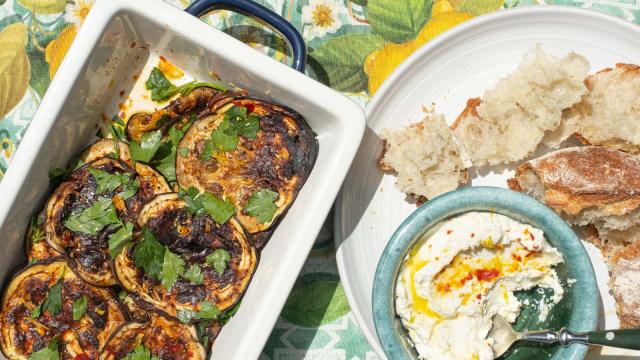When consumed in casseroles and sandwiches, “breaded and fried” seems to be the default preparation method for eggplant. As a person of Southern origin, I am not opposed to a breaded and/or fried thing, but eggplant doesn’t need it. There are two other efficient ways to prepare eggplant for layering into casseroles and sandwiches, and neither of them require an egg dip.
Fry it on salt
We’ve covered this method before, but it works so well (and I have been using it so often), it deserves to be highlighted again. A.A. Newton first learned of the technique in one of Kris Yenbamroong’s Instagram stories, and it has to be the least fussy eggplant prep technique I’ve ever seen:
Instead of salting the eggplant and frying it in quarts of oil, he tosses raw, totally un-prepped slices into a salted pan with no oil at all. The cooked eggplant slices get layered with copious amounts of olive oil, garlic, chilli flakes, and herbs, like a lasagna.
In addition to the complete lack of salting and draining, this method is also devoid of cooking oil. Yenbamgroong finishes the salt-fried slices with olive oil after they’re cooked, but the super hot, dry salt gives the eggplant smoky, evenly charred outsides and silky insides, without any soggy spots. (Salt, as it turns out, gets incredibly hot in a pan, so any moisture coming out of the eggplant evaporates quickly.)
You can layer these deeply browned slices in a casserole dish with lots of herbs, aromatics, oil, and/or a crumbly funky cheese, or you can take all that and put it on a roll (hoagie, hero, sub — whatever the hell you call it). I have been drizzling slices with garlic honey and eating them as a side, and I find it to be quite pleasing.
Salt, then bake (in lots of oil)
A few weekends ago, I asked A.A. Newton (the undisputed eggplant queen), if she could recommend a good recipe for eggplant parm. “The Food52 genius recipe version,” she replied. “Baking the slices instead of frying >>>>>.”
The recipe, I am happy to report, is not only genius, but an exercise in elegance and restraint. The sauce is a three-ingredient banger, and the eggplant step is startlingly — almost suspiciously — simple. All you have to do in terms of prep is peel the eggplant, slice it into 1/4-inch planks (though I did rounds), salt the slices, layer them in a colander, and weigh them down with a heavy plate or tea kettle filled with water. After half an hour, pat the slices dry with paper towels and dredge them in flour, making sure to tap off the excess.
Next, oil up a couple of baking sheets (or one very large one), adding just enough to lightly coat the bottom, and place the dredged eggplant slices on the baking sheet. Drizzle a little more oil on each slice and cook in an oven heated to 230 degrees C until the tops are browned, then flip ‘em over to brown the bottoms. It sounds too simple to be worthy of the name eggplant parm, but it works.
I am not an Italian American, but my boyfriend is, and he was sceptical that this would result in a good eggplant parm. “They’re not breaded?” was all he asked, before retreating to the safety of the living room, but that was enough. Though he daren’t say more — for I had given him a look — I knew he did not have confidence in this recipe.
He may be Italian-American, but I am the better cook, and A.A. Newton knows her eggplant, and I was right to trust her recommendation, and trust the process of this recipe. One bite and the sceptical Italian man declared it to be the best he’d ever had. It was a perfect mouthful of crisp but custardy eggplant, tangy, garlicky, marinara, and gooey, salty cheese. There was no soggy breading, no oddly separated egg layer, much less oil to clean up, and no greasy residue in my hair from pan frying.
This oven fried, crisp but custardy eggplant is incredible in a parm situation, but it could also be layered with herbs and alliums like the salt-fried eggplant discussed above, or shoved into a simple, non-parm sandwich. I would try the parm though. The parm is very good.

Leave a Reply
You must be logged in to post a comment.